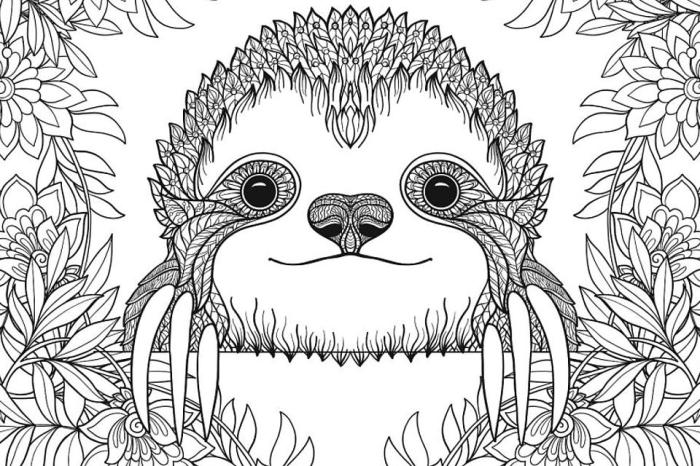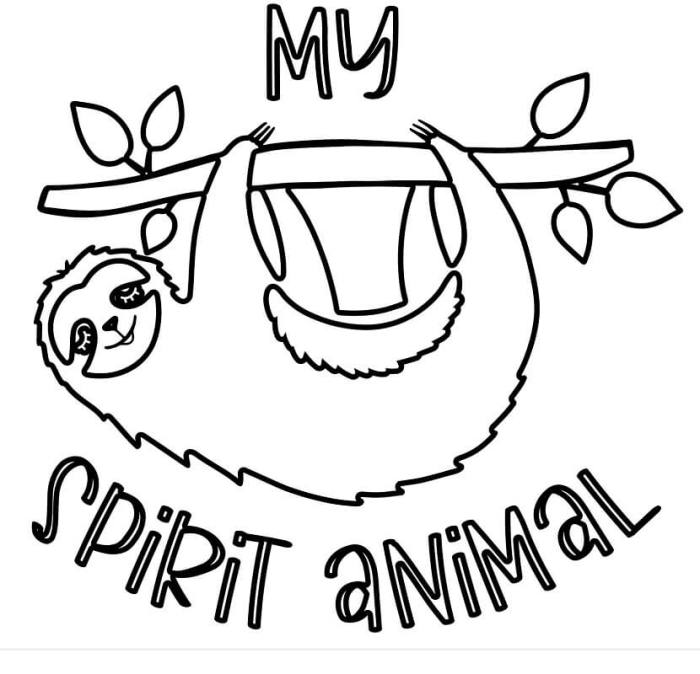Sloth Coloring Page Designs
This section details three sloth coloring page designs, each tailored to a different age group: preschool, elementary school, and teens/adults. The designs vary in complexity, line thickness, and overall aesthetic to ensure age-appropriateness and engagement.
Sloth coloring pages offer a relaxing creative outlet, perfect for unwinding. If you enjoy nature-themed coloring, you might also appreciate the intricate details found in mushroom coloring pages printable , which offer a similar sense of calm. Returning to sloths, their gentle nature makes them a popular subject for coloring, especially for younger artists.
Sloth Coloring Page Design Specifications
Three distinct sloth coloring page designs are presented below, catering to different age groups and skill levels. Each design considers the developmental capabilities and artistic preferences of its target audience.
Preschool Sloth Design: This design features a large, simplified sloth with thick, bold Artikels. The details are minimal, focusing on easily colorable shapes like circles for the body and head, and simple lines for the limbs and face. The aesthetic is playful and cartoonish, using bright, cheerful colors. Line thickness is approximately 10-12 points. The overall complexity is low, making it ideal for young children with developing fine motor skills.
Imagine a friendly, smiling sloth with large, expressive eyes.
Elementary School Sloth Design: This design presents a more detailed sloth, incorporating more intricate features such as fur texture suggested by short, closely spaced lines, simple leaf shapes, and perhaps a branch for the sloth to cling to. The lines are thinner, approximately 5-7 points, allowing for more precise coloring. The aesthetic is still friendly and approachable but offers a greater challenge for older children.
The complexity is moderate, encouraging creativity and color blending techniques. The sloth might be shown hanging from a tree branch, with some simple background elements.
Teens/Adults Sloth Design: This design features a highly detailed sloth, possibly in a more realistic or stylized manner. The linework is thin, around 2-3 points, requiring precision and patience. The design incorporates complex textures, shading suggestions, and possibly a more elaborate background scene, such as a rainforest environment. The aesthetic is sophisticated and visually appealing, allowing for artistic expression and detailed coloring.
The complexity is high, catering to the advanced skills and preferences of older individuals. The sloth might be depicted in a more naturalistic pose, perhaps with intricate details in its fur or the surrounding environment.
Comparison of Sloth Coloring Page Designs
The following table summarizes the key differences between the three sloth coloring page designs:
| Design Name | Target Age | Line Thickness Description | Complexity Level |
|---|---|---|---|
| Preschool Sloth | Preschool (Ages 3-5) | Thick (10-12 points) | Low |
| Elementary Sloth | Elementary School (Ages 6-12) | Medium (5-7 points) | Moderate |
| Teen/Adult Sloth | Teens/Adults (Ages 13+) | Thin (2-3 points) | High |
Suggested Color Palettes
Preschool Sloth: Bright, primary colors (red, yellow, blue) along with greens and browns for the background. Consider using vibrant, easily distinguishable colors to stimulate visual engagement.
Elementary School Sloth: A wider range of colors, including earth tones (browns, greens, beige) and some brighter accent colors. This allows for more creative color mixing and shading. Suggest using a color chart to show examples of harmonious color combinations.
Teens/Adults Sloth: A more nuanced palette, possibly incorporating muted tones, complementary colors, and subtle shading. Encourage the use of color pencils or markers for finer detail and blending. This palette should allow for a more sophisticated and artistic approach to coloring.
Sloth Anatomy for Coloring Pages

Creating accurate and engaging sloth coloring pages requires understanding the animal’s key anatomical features. This section details the essential elements to include, offering simplified representations suitable for various age groups and exploring techniques for depicting fur texture.
Accurate depiction of a sloth’s anatomy enhances the educational value of the coloring page, allowing children to learn about the animal’s unique characteristics while having fun. Simplified representations make the coloring process easier for younger children, while more detailed versions challenge older children and adults.
Simplified Anatomical Representations for Different Age Groups
The level of detail in a sloth’s anatomy should be adjusted based on the target age group. Younger children benefit from simpler shapes and fewer details, while older children can handle more complex features.
- Ages 3-5: Focus on basic shapes. The body can be a rounded oval, the head a smaller circle, and the limbs simplified into short, stubby shapes. Eyes can be large, simple circles. Minimal detail is needed.
- Ages 6-8: Introduce more refined shapes. The body can be more elongated, with slightly curved lines. Limbs can be more accurately represented with fingers and toes. Add simple facial features like a small nose and mouth.
- Ages 9-12 and Adults: Include more detailed anatomical features. Show the characteristically long limbs, curved claws, and the slightly hunched posture. More detailed facial features and fur texture can be incorporated.
Depicting Fur Texture in Sloth Coloring Page Designs
The texture of a sloth’s fur is a significant visual element. Different artistic styles can effectively convey this texture, offering varied challenges and aesthetic appeal for colorists.
- Hatching and Cross-Hatching: This technique uses short, parallel lines to create shading and texture. Closely spaced lines create darker areas, representing denser fur, while wider spacing suggests lighter areas. Cross-hatching adds another layer of depth by overlaying lines at angles.
- Stippling: This involves creating texture through small dots. Closer dots create darker, denser fur, while further spaced dots represent lighter areas. Varying the size and density of the dots can add further complexity and visual interest.
- Scribbling: A less structured approach, scribbling involves using short, irregular lines to create a textured effect. This is suitable for younger children and can produce a more playful, less realistic representation of the fur.
- Color Blending: This method uses different shades of a color to create a sense of depth and texture. Lighter shades can represent highlights, while darker shades create shadows, conveying the three-dimensionality of the fur.
Sloth Habitats and Environments for Coloring Pages
Sloths are fascinating creatures, and understanding their habitats is key to accurately depicting them in coloring pages. Their environment significantly influences their behavior and appearance, providing opportunities for creative and informative coloring page designs. This section will explore three distinct sloth habitats, offering background scene suggestions and sloth pose ideas for each.
Rainforest Canopy Habitat
The rainforest canopy is the primary habitat for most sloth species. This dense, layered environment provides abundant food sources (leaves, buds, and tender shoots) and protection from predators. The high humidity and relatively stable temperatures contribute to the sloth’s slow metabolism.
For a coloring page, depict a vibrant, lush canopy. Include large, leafy trees with intertwining branches, dappled sunlight filtering through the leaves, and perhaps a glimpse of the forest floor far below. One sloth could be hanging upside down from a branch, its long claws firmly gripping the wood. Another could be slowly moving along a vine, its body elongated and relaxed.
A third sloth might be clinging to a thick branch, comfortably nestled among the leaves, partially obscured by foliage.
Tree Branch Habitat
While the rainforest canopy is their home, sloths frequently utilize individual branches for resting, feeding, and even sleeping. The specific branch chosen often depends on its size, strength, and proximity to food sources.
A coloring page depicting a tree branch habitat could focus on a single, sturdy branch with detailed texture. The background could be a simple, less detailed representation of the surrounding canopy, allowing the branch and sloth to be the focal point. One sloth might be curled up asleep on the branch, its fur blending with the bark. Another could be carefully reaching for a leaf, its limbs extended.
A third could be perched on the branch, observing its surroundings with a calm expression.
Ground Habitat
Although primarily arboreal, sloths occasionally descend to the ground, usually for defecation (once a week) or to move between trees. This is a vulnerable time for them, as they are much slower and more exposed to predators on the ground.
For a ground-level coloring page, depict a shaded forest floor with scattered leaves, roots, and perhaps a small stream or puddle. The background could include the lower trunks of large trees and undergrowth. A sloth could be slowly moving across the forest floor, its limbs carefully placing each step. Another might be pausing to eat a fallen leaf. A third could be depicted near a tree trunk, looking up towards the canopy, perhaps looking for a way to climb back up.
Sloth Interaction with Other Rainforest Animals, Sloth coloring page
Imagine a scene where a three-toed sloth hangs peacefully from a branch, a colorful macaw perches nearby on the same branch, seemingly unfazed by the sloth’s presence. Below, a family of monkeys playfully swings through the trees, their movements a stark contrast to the sloth’s slowness. A vibrant morpho butterfly flits around the sloth’s head, adding a touch of magical realism to the scene.
The overall feeling is one of calm coexistence and natural harmony, with the sloth integrated into the lively rainforest ecosystem without any sense of conflict or threat. The color palette should reflect the vibrancy of the rainforest, with greens, browns, blues, and pops of bright colors from the animals.
Creative Variations of Sloth Coloring Pages

Enhancing the basic sloth coloring page design opens up a world of creative possibilities, catering to diverse interests and skill levels. By incorporating fantasy elements, puzzle components, or educational information, we can transform a simple coloring activity into a more engaging and enriching experience. These variations encourage imaginative play and expand learning opportunities beyond the basic act of coloring.
Fantasy Sloths
A whimsical approach involves adding elements of fantasy to the sloth design. Imagine a sloth with iridescent, butterfly-like wings, soaring through a vibrant, fantastical landscape. Alternatively, the sloth could wear a tiny wizard’s hat and robe, holding a miniature magic wand. Details like sparkling gemstones adorning its fur or a halo of stars surrounding its head further enhance the magical feel.
The background could depict a mystical forest filled with glowing flora and fauna, creating a captivating scene for the child to color. This approach allows for a vast range of creative expression, transforming the familiar sloth into a magical creature.
Sloth Puzzle Coloring Pages
Integrating a puzzle element adds a layer of complexity and engagement. This could involve incorporating a hidden picture within the sloth’s fur, requiring the child to carefully color to reveal the secret image. Another approach would be to design the sloth as a jigsaw puzzle, with various pieces forming the complete image. The pieces could be numbered for easier assembly or presented as a more challenging, free-form puzzle.
This variation combines coloring with problem-solving, fostering cognitive development while providing artistic expression. Consider a sloth composed of geometric shapes, each requiring a different color or pattern.
Educational Sloth Coloring Pages
Incorporating educational elements transforms the coloring page into a learning tool. A sloth coloring page could feature a simple map of its habitat, highlighting key features like the rainforest canopy. Another approach could be to depict different sloth species, each labeled with its scientific name and a brief description of its unique characteristics. Alternatively, the page could include facts about sloth behavior, such as their slow movement, their diet of leaves, or their unique symbiotic relationship with algae.
The coloring activity becomes a subtle but effective way to learn about these fascinating creatures and the importance of their conservation. A simple infographic showing the threats sloths face, like deforestation, could be incorporated.
